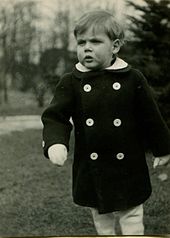Hamburg nursery
The Hamburger Kinderstube was a salon for exclusive children's clothing, which became known and style-forming beyond the borders of the Hanseatic city. Alice Haas (daughter of Hofrat Dr. Friedrich Erdmann-Jesnitzer from Bremen ) and her husband Richard founded it in 1925. Their fashion designs were based on a reform pedagogical approach. The children's fashion business continued with one interruption until 1988.
First years
The trained plasterer Alice Haas visited the fashion department of Otto Haas-Heye's arts and crafts school in Prinz-Albrecht-Straße 8 in Berlin in the 1920s .
In 1925 she opened the Hamburg nursery with an attached tailor's workshop near the Hamburg Dammtorbahnhof in Rothenbaumchaussee No. 3. In 1928, the business moved to Neuer Wall . In 1934 it found its final place at Jungfernstieg 34.
Fashion
The motto of the nursery was: The child should be dressed like a child. Until World War I , children were dressed like little adults. Corsets that were harmful to health were common, sometimes also for boys.
The Hamburger Kinderstube , on the other hand, propagated a functional, simple, but definitely high-quality clothing style. Alice Haas used easily washable fabrics and child-friendly cuts, colors and patterns. She designed short pendent dresses with smocked yokes , tartan check dresses , sailor blouses, simple smock suits for boys and navy blue cloth coats with white piquet collars and mother-of-pearl buttons. Some designs were reminiscent of British fashion at the time. The models got wide, removable hems and detachable cuffs, collars and elastic bands. A patch bag with suitable ingredients was added to each item of clothing. The dress should grow with the child.
The dresses were made according to a made-to- measure system . Sewn as a ready-made product, but handcrafted. On request, a purely made-to-measure product was commissioned. Some of the models were made at home.
Despite all the emphasis on simplicity: the clothing was not intended for the general public. It was produced in small numbers and sold at high prices. Since the shop also offered patterns and fabrics of his creations, ordinary people could also follow this fashion with self-tailoring.
success
As early as 1926, the Hamburg nursery began to expand and opened branches in a number of large cities. The openings were accompanied by benevolent media coverage. The Rheinische Zeitung wrote : There are all sorts of children's clothing stores in Cologne, and yet it seems as if the Hamburg nursery is a completely new, unique company. This is the first time that 'children's clothes' have been created, not women's clothes.
In 1936 Alice Haas was commissioned to design dresses for the dragons of the wedding of the Dutch Crown Princess Juliana and Prince Bernhard . This order, which was carried out in a very short time, made the nursery known far beyond the borders of Germany.
Political difficulties
After the seizure of power , Richard Haas, who was of Jewish origin, emigrated to Great Britain. In 1939 the 19-year-old daughter Renate joined the company. Due to the events of the war and the persecution of Jewish business partners, most of the sales outlets spread across Germany had to be abandoned. The fashionable style of the store was preserved. After the war, the company grew again and produced collections for other European countries and the USA.
Young salon
In 1953 the Junge Salon was opened next to the nursery on the initiative of Renate Haas . Renate Haas created a clothing line for girls and young women between the ages of 13 and 20 - a generation between backfish and teenagers . The palette ranged from fashionable, classic day, dance class and evening dresses to short suits reminiscent of childish shirt trousers. The boy salon was successful. Well-known photographers such as Hubs Flöter or FC Gundlach featured them in leading women's magazines such as Film und Frau , Constanze and Brigitte . The exclusive clientele included Romy Schneider , the princely family of Monaco and the Shah of Persia .
Last years
Over the years, the directions of fashion changed with the times. Jeans found their way, but not in the boy's salon . In the eighties there was a renaissance of hanging dresses and plaids. The Hamburg nursery was able to fall back on old patterns.
In 1988 Renate Haas sold the brand name Hamburger Kinderstube to Berlin and closed the company. She bequeathed his estate to the textile department of the Museum of Arts and Crafts. It mainly contains written material: letters, documents, drawings and patterns, as well as individual models.
literature
- Gesa Kessemeier: fashion for children from a good family. The “Hamburger Kinderstube 1925–1988” in: Yearbook of the Museum für Kunst und Gewerbe Hamburg , Volume 15/16, 1996–1997, pp. 143–154. Published by the Museum für Kunst und Gewerbe in collaboration with the Paul Hartung Verlagsgesellschaft Hamburg 1999. ISBN 3-923859-45-7
See also
House Stübekamp 75 with a small portrait of a home worker from the Hamburg nursery .

